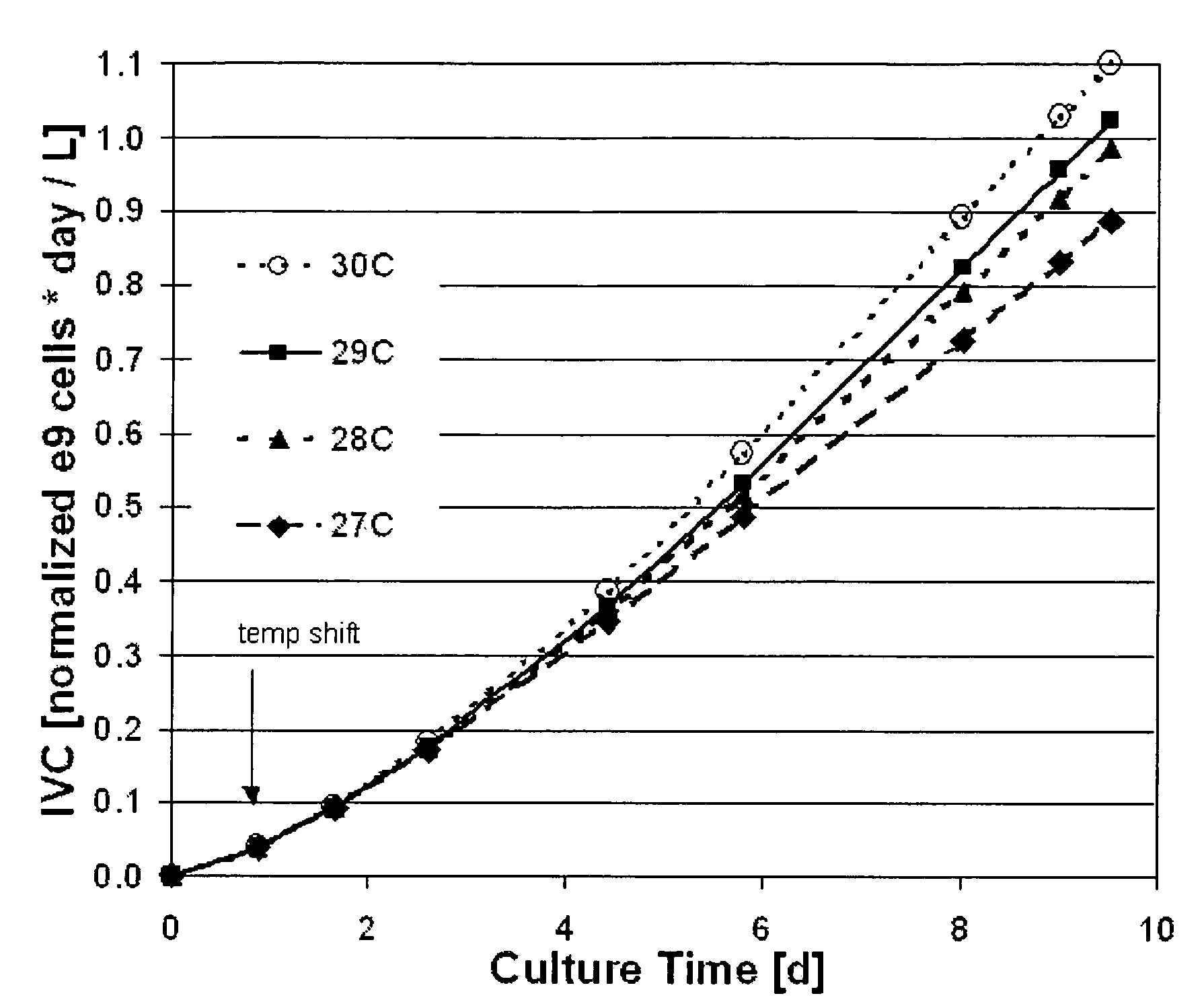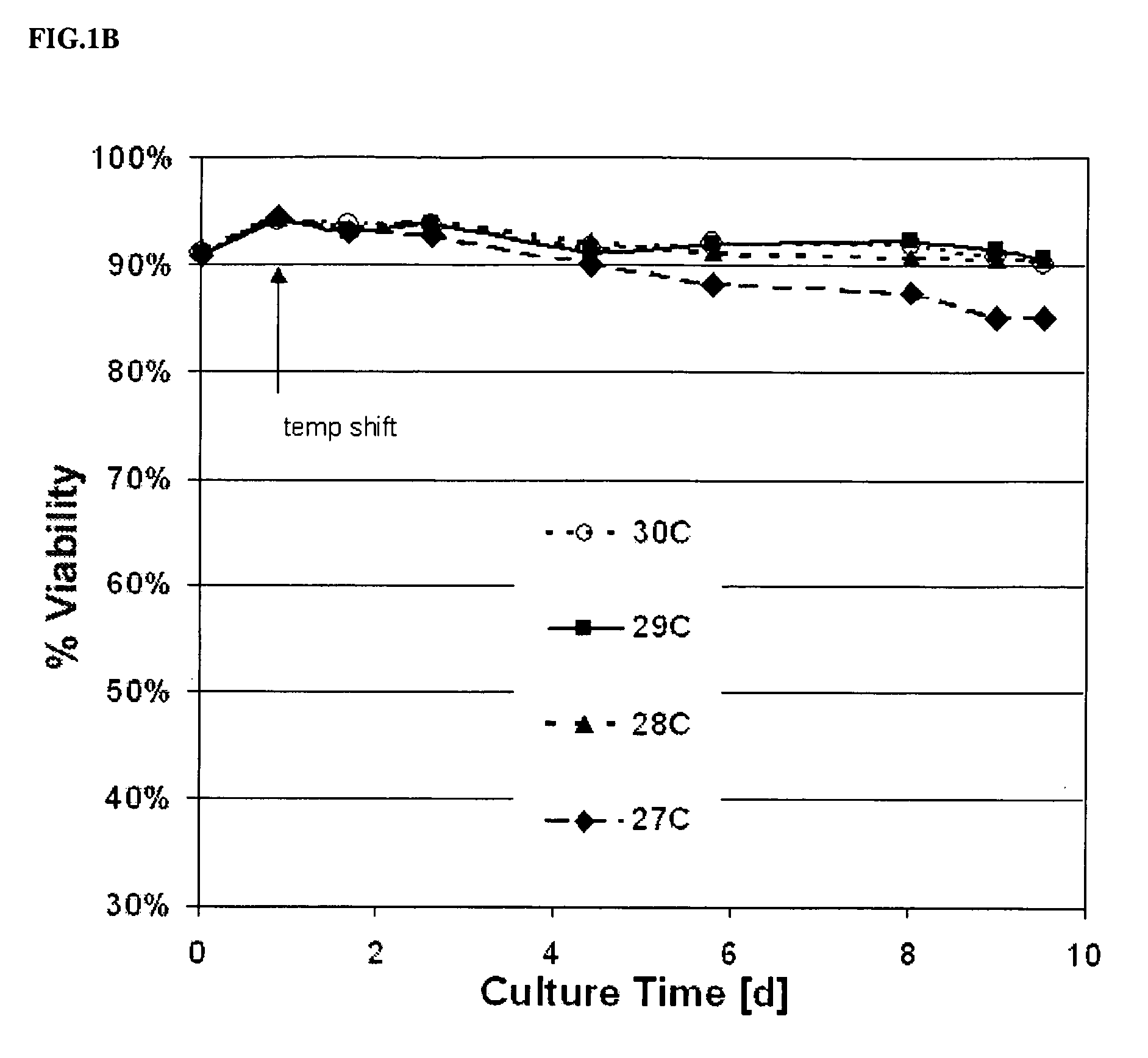Use of low temperature and/or low ph in cell culture
a cell culture and low temperature technology, applied in the field of cell culture, can solve the problems of large proportion of product which is aggregated, large portion of protein product produced in misfolded or aggregated form, failure of clinical trials, etc., to reduce misfolded production, increase temperature and/or ph, and reduce temperature and/or ph
- Summary
- Abstract
- Description
- Claims
- Application Information
AI Technical Summary
Benefits of technology
Problems solved by technology
Method used
Image
Examples
example 1
TNFR-Fc Protein Production
Example 1.1: Effects of Reduced Temperature on Cell Culture Performance of Recombinant CHO Cells and on Product Quality of TNFR-Fc Fusion Protein
example 1.1.1
Methods
[0108]Chinese Hamster Ovary (CHO) cells overexpressing recombinant glycoprotein TNFR-Fc were inoculated at identical concentrations and conditions in four separate bench-scale bioreactors at 37.0° C. Cells were grown in a fed-batch culture for one day, followed by a temperature-shift to either 30.0° C., 29.0° C., 28.0° C., or 27.0° C. The initial pH set point lower limit of the culture was 7.00. A cell sample was removed from the culture each day to measure various conditions of the cells culture, e.g., integrated viable cell numbers, cell viabilities, residual glucose profile, residual glutamine profile, lactate and ammonia concentrations, cumulative average cell productivity (Qp), product titer, levels of misfolded / aggregated product, levels of high molecular weight aggregates, levels of sialylation, and pH.
[0109]Integrated viable cell numbers (IVC) were calculated by measuring cell density using cell-density examination (e.g., CEDEX®, Innovatis, Malvern, Pa.) and were norm...
example 1.1.2
[0113]Growing cells at a reduced temperature had minimal effects on IVC number. Specifically, lower operating temperatures resulted in a lower final IVC number; however, the effect of reducing cell culture temperature to 27° C. was minor - only about a 20% decrease in the IVC number was observed (FIG. 1A) Cell viabilities were not greatly affected by the decrease in temperature; the lowest temperature condition (i.e., 27° C.) had 5% lower harvest day viability (FIG. 1B).
[0114]Additionally, reduced operating temperatures resulted in a higher residual glucose profile, which indicated lower glucose consumption of the cell culture (FIG. 2A); however glutamine profiles were not significantly altered by reduced temperatures (FIG. 2B).
[0115]In some cases, late in the cell culture, lactic acid and ammonia may also be consumed by the cell culture. The cessation of the production of lactic acid and ammonia or the consumption of lactic acid and ammonia promote cell viability, cell productivity...
PUM
| Property | Measurement | Unit |
|---|---|---|
| Temperature | aaaaa | aaaaa |
| Temperature | aaaaa | aaaaa |
| Temperature | aaaaa | aaaaa |
Abstract
Description
Claims
Application Information
 Login to View More
Login to View More - R&D
- Intellectual Property
- Life Sciences
- Materials
- Tech Scout
- Unparalleled Data Quality
- Higher Quality Content
- 60% Fewer Hallucinations
Browse by: Latest US Patents, China's latest patents, Technical Efficacy Thesaurus, Application Domain, Technology Topic, Popular Technical Reports.
© 2025 PatSnap. All rights reserved.Legal|Privacy policy|Modern Slavery Act Transparency Statement|Sitemap|About US| Contact US: help@patsnap.com



